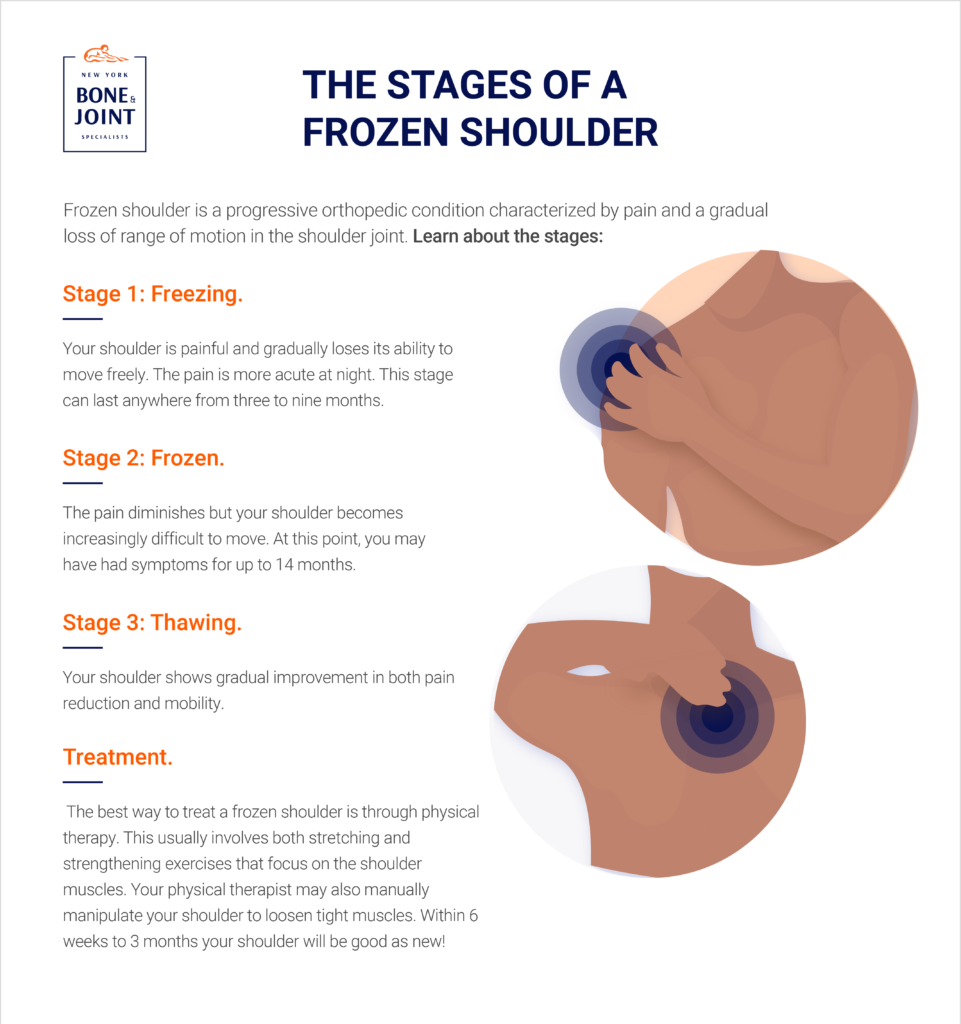Is a stiff shoulder making it difficult to do your daily activities? It’s time to get your frozen shoulder thawed.
The shoulder is one of the most mobile joints in the body, allowing you to move your arm in every direction. The joint’s mobility enables you to do everything from play sports to reach for an item on a shelf or put on a jacket. It’s easy to take your shoulder for granted — at least it is until the joint stiffens up and performing all those normal activities becomes exceedingly painful. When that happens, it’s likely the result of a frozen shoulder, or adhesive capsulitis.
Frozen shoulder is a progressive orthopedic condition characterized by pain and a gradual loss of range of motion in the shoulder joint. The condition may resolve on its own, but that process can take years if it even happens. If you don’t want to wait that long, a conservative program of physical therapy can thaw your frozen shoulder more quickly and effectively.
The Causes & Stages of Frozen Shoulder
Your shoulder is a ball-and-socket joint that connects your upper arm bone (humerus), your shoulder blade (scapula), and collarbone (clavicle). Holding the bones together is a band of connective tissue known as the shoulder capsule. With the help of lubricating synovial liquid, that connective tissue allows the joint to rotate smoothly. If the shoulder capsule becomes inflamed, it will thicken, keeping the shoulder from moving freely.
While we know that this is how frozen shoulder occurs, the reason why it happens is still a matter of debate. Unlike many other conditions, frozen shoulder has no definitive cause. However, there are several factors that increase your chances of developing a frozen shoulder.
Generally speaking, the condition typically affects people over the age of 40 and it strikes more women than men. If you’ve undergone a surgery or suffered an injury that immobilizes your arm for a long period, you are also at greater risk of your shoulder becoming stiff and painful. Additionally, chronic conditions such as diabetes or Parkinson’s disease can increase a person’s chances of developing a frozen shoulder.

Once you have a frozen shoulder, the condition will advance in three distinct stages:
Stage 1: Freezing. Your shoulder is painful and gradually loses its ability to move freely. The pain is more acute at night. This stage can last anywhere from three to nine months.
Stage 2: Frozen. The pain diminishes but your shoulder becomes increasingly difficult to move. At this point, you may have had symptoms for up to 14 months.
Stage 3: Thawing. Your shoulder shows gradual improvement in both pain reduction and mobility. It could take anywhere from six months to two years for your joint to return to normal or almost normal range of motion. Physical therapy can reduce this time frame.
Treating Frozen Shoulder
It’s important that you begin treatment for your frozen shoulder at the earliest possible stage to prevent further pain and restricted movement. Don’t wait for it to resolve on its own because there’s no guarantee the joint will ever return to full mobility without professional intervention.
Typically, treatment for a frozen shoulder begins with a conservative approach of physical therapy and medications where necessary. In severe cases where these interventions are insufficient, a doctor may recommend surgery.
Physical Therapy. Physical therapy for a frozen shoulder involves both stretching and strengthening exercises that focus on the shoulder muscles. Your physical therapist may also manually manipulate your shoulder to loosen tight muscles. Before treatment, the physical therapist may apply ice or heat to relax the muscles. Your physical therapist may also give you exercises to do at home so you maintain some movement between sessions.
Medications. Over-the-counter pain medications or prescription anti-inflammatory drugs can reduce the pain of a frozen shoulder. To temporarily relieve pain, your doctor may also prescribe a corticosteroid injected into the joint.
Surgery. There is a range of surgical options for a frozen shoulder, from minimally invasive to more intensive. One milder treatment option is hydrodilatation, where a sterile liquid injected into the shoulder capsule loosens the tissues and increases the range of motion. In rare cases, a frozen shoulder will require more severe surgery. Typically this surgery involves the doctor using tubular instruments that are inserted into the shoulder through small incisions. The doctor then breaks up the scar tissue and adhesions in an arthroscopic procedure.
Recovery time for each of the methods could take anywhere from six weeks to three months. Success depends on following through with your physical therapy program. But the good news is that once you’re fully recovered, you will be able to return to normal activities with no pain and a full range of motion!
Thaw Your Frozen Shoulder and Get Moving Again
Joint stiffness is a common orthopedic problem. If you think you might have a frozen shoulder or if you’re experiencing any other problems with joint stiffness, it’s important that you see a doctor right away so you can stop the problem in its tracks. The orthopedists and physical therapists at New York Bone & Joint Specialists have worked with thousands of patients to unlock stiff shoulders, knees, and other joints. Contact us today for a consultation to see how we can help you feel your best.




